Ebony - Chin 1 - Homozygous Ebony (AA) + Chin 2 - Heterozygous Ebony (Aa)
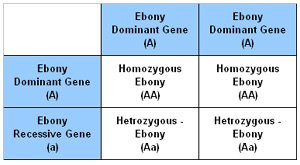
 Breeding heterozygous and homozygous Ebonies together produces a 50-50 split in offspring identical to their parents. The outcome will either be 50% heterozygous or 50% homozygous. The differences between these offspring will be intensity of colour depending on how many generations the Ebony gene has been passed through.
Breeding heterozygous and homozygous Ebonies together produces a 50-50 split in offspring identical to their parents. The outcome will either be 50% heterozygous or 50% homozygous. The differences between these offspring will be intensity of colour depending on how many generations the Ebony gene has been passed through.
TOV Standard (Black Velvet) - Chin 1 - TOV Standard (Aa) + Chin 2 - Standard Grey (aa)
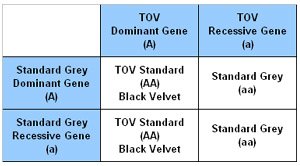

The Standard TOV is the basis of all TOV. The combination of breeding a Standard TOV to a Standard Grey chinchilla will produce 50% Standard TOV - also known as Black Velvet and 50% Standard Grey.
Below are some more colour mutations that are often seen within the chinchilla world. Using Punnet Squares we can see how some of these different mutations are produced and the colour genes needed to achieve these particular colour mutations.
The 'Tan' mutation colour is produced by breeding Beige and Ebony chinchillas together. The intensity of the colour varies intensely depending on how many generations the Ebony gene has been passed through. The Ebony gene also creates a 'wrapping' effect where the chinchilla's underbelly will be dark rather than the usual White.
Tan - Chin 1 - Heterozygous Beige (Aa) + Chin 2 - Heterozygous Ebony (Aa)
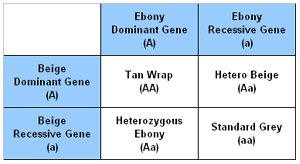
 Breeding together a heterozygous Beige and a heterozygous Ebony produces 25% Tan Wrap, 25% Heterozygous Beige, Heterozygous Ebony and 25% Standard Grey.
Breeding together a heterozygous Beige and a heterozygous Ebony produces 25% Tan Wrap, 25% Heterozygous Beige, Heterozygous Ebony and 25% Standard Grey.
TOV Beige (Brown Velvet) - Chin 1 - TOV Standard (Aa) + Chin 2 - Heterozygous Beige

 Many different outcomes are produced when combining a TOV to another colour mutation. In this example the resulting offspring will be 25% Standard TOV, 25% Standard Grey, 25% Hetero Beige and 25% TOV Beige (known as Brown Velvet).
Many different outcomes are produced when combining a TOV to another colour mutation. In this example the resulting offspring will be 25% Standard TOV, 25% Standard Grey, 25% Hetero Beige and 25% TOV Beige (known as Brown Velvet).
The White gene is also responsible for a variety of colour mutations two of which are listed below.
White Violet - Chin 1 - Heterozygous White (Aa) + Chin 2 - Homozygous Violet (AA)
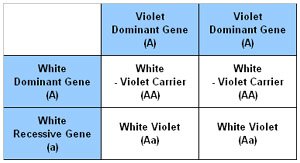
 White Violet is another beautiful colour mutation created from a White chinchilla and a Homozygous Violet chinchilla. The punnet square shows a production of 50% White Violet and 50% White Violet Carriers.
White Violet is another beautiful colour mutation created from a White chinchilla and a Homozygous Violet chinchilla. The punnet square shows a production of 50% White Violet and 50% White Violet Carriers.
Pink White - Chin 1 - Heterozygous White (Aa) + Chin 2 - Heterozygous Beige (Aa)

 Combining a White and Beige with this genetic structure produces 25% Pink White, 25% White Mosaic, 25% Heterozygous Beige and 25% Standard Grey offspring.
Combining a White and Beige with this genetic structure produces 25% Pink White, 25% White Mosaic, 25% Heterozygous Beige and 25% Standard Grey offspring.
There are many many different combinations you can produce with the use of Punnet Squares and the list is endless. Hopefully this section on Chinchilla Genetics and Punnet Squares has helped you understand how different colour mutations are achieved and the truth behind the Fatality Gene of the White and TOV chinchillas.
Chinchilla Genetics is a massive subject and covers not only colour influence but also:
- Health
- Quality of Fur
- Temperament
- Size
- Behavior
...and more.
An Essential Guide to Owning a Chinchilla is an excellent hardback book covering every aspect of chinchilla care including breeding and genetics has now sold over 4,000 copies worldwide!
The book has over 140 beautiful coloured photographs showing the colour mutation, name, age and sex of the chinchillas written underneath, together with information on Behavior, Standards of Health, Quality of Fur and Temperament.

Many chinchilla owners have found An Essential Guide to Owning a Chinchilla one of the best chinchilla books currently on the market and have kindly left reviews about the book for you to read.
If you want to learn more about Chinchilla Genetics and the whole Breeding Process then this is a chinchilla book just for you...
Read More....

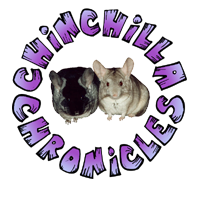







 Many different outcomes are produced when combining a TOV to another colour mutation. In this example the resulting offspring will be 25% Standard TOV, 25% Standard Grey, 25% Hetero Beige and 25% TOV Beige (known as Brown Velvet).
Many different outcomes are produced when combining a TOV to another colour mutation. In this example the resulting offspring will be 25% Standard TOV, 25% Standard Grey, 25% Hetero Beige and 25% TOV Beige (known as Brown Velvet).



